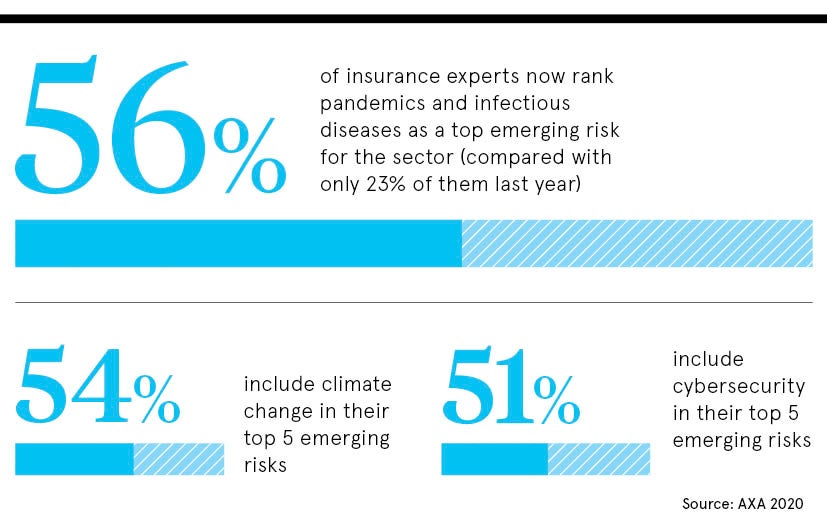
The novel coronavirus has upended all parts of everyday life, including the insurance industry. Thousands of customers called in policies as holidays were cancelled and unforeseen closures were forced upon firms. Insurers have never been busier.
But there have been negative headlines alongside financial reassurance. A recent case over 21 specific wordings of business interruption insurance policies, brought to the High Court by the Financial Conduct Authority, has turned a spotlight on the industry.
“It’s a reminder to everyone, both insurers and customers, about the importance of contract wordings,” says Huw Evans, director general of the Association of British Insurers. The future of insurance relies on how the industry responds to negative headlines, how it charts a path through the post-coronavirus world and how it chooses to embrace digital transformation in the sector.
“COVID-19 has been a huge operational resilience stress test,” says Evans. “Can the systems hold up, can you move hundreds of thousands of people to working from home? Can you issue new claims and pension payments while working correctly?”
So far, the industry has come through with vigour and resolve, maintaining strong customer service and keeping its business model strong. It’s also improved transparency, making sure the industry is open about what it does and why it does it, helping maintain customer loyalty and assurance.
But the pandemic has also reassured people of the importance of insurance. “This horrible pandemic, with the terrible loss of life involved has, like all catastrophic events, reminded people things can go wrong in life,” says Evans.
Neil Clutterbuck, chief underwriting officer at Allianz UK, adds: “COVID-19 has suddenly created this situation where we thought we lived in a world that had a degree of certainty, but has moved the goal posts considerably.”

Speeding up digital transformation in insurance
And, like every other industry out there, the pandemic has sped up the use of digital technologies. Digital transformation in the insurance industry has been building up steam for years, but the rapid shifts that have rocked the world have condensed decades of change into months. The future of insurance is no longer the future; instead it’s the present.
“It’s been a reminder of how much of our work is digitally enabled,” says Evans. It has accelerated the process of insurers thinking about what types of products people want and how they want to interact with their insurance providers. The future of insurance has long been heralded as a world where data analytics is key and digital technologies sweep away legacy systems run by traditional insurers.
At the start of the pandemic, half of Allianz customers using particular insurance products transacted with the firm digitally. “During the COVID-19 period, that’s shot up to 80 per cent for certain lines,” says Clutterbuck. “Customers are unlikely to go back, having got familiar with transacting in that way.”
Much of the data needed to affect digital transformation in the insurance industry already exists and is available to insurers. Whereas, in the past, customers would have to report where they lived and whether it was near a water source that was a flood risk, insurers can now simply look at a map and model the flood risk for any property. “We’re living in a world where sources of data are exploding, not just growing,” says Evans.
Predictive analytics make insurance smarter
That data explosion helps make insurance more efficient and brings benefits to customers. Clutterbuck explains: “You get greater insight and the ability to use that data to really fine-tune products.”
But not everyone wants to hand over their life’s data. “How far it will go is partly dependent on how much customers give permission,” says Evans, who foresees a market for those who wish to maintain control over more of their data, but perhaps will require a “more risk-reflective policy” and payments.
We already see this in the car insurance world. “Some drivers are very happy to have black-box telematics if it means their policy is judged on how they drive and their driving patterns,” he says. “Other customers feel that’s an intrusion.” Such usage-based insurance, however, is important in a world where we’re as likely to rent vehicles as we are to buy them outright.
“I think we’ll see more single-use insurance, where people pay per mile for car usage,” says Evans. Likewise, so-called “parametric” insurance, where customers buy a specific amount of cover for something, is becoming more popular as finances are strained and customers feel better able to judge their own risks.
Changes driven by young consumers and insurtech
Younger consumers may also prefer to buy data or cyberinsurance, protecting the information on their phones, laptops and in the cloud. “They want to protect that as much as 20 years ago they wanted to protect a TV,” says Evans. But the industry has to work hard to build up trust that it’s able to handle data responsibly.
“We need to do more to reassure customers their personal data is safe with us and how we use their data is clear and transparent,” he concedes. Partly, this can be done by building better relationships with customers, which is where the raft of new insurtech startups are charting the course for the future of insurance. “They’re focused on how we can engage better with the customer,” says Evans. “In that perspective, insurtech startups have been a real positive for our sector.”
But they’re not working alone. Digital transformation in the insurance industry is happening because of collaboration between insurtech startups and the traditional insurers that have spent centuries building up the industry. Together they’re mapping out where the insurance industry is headed in a post-coronavirus world and the future looks bright.

The novel coronavirus has upended all parts of everyday life, including the insurance industry. Thousands of customers called in policies as holidays were cancelled and unforeseen closures were forced upon firms. Insurers have never been busier.
But there have been negative headlines alongside financial reassurance. A recent case over 21 specific wordings of business interruption insurance policies, brought to the High Court by the Financial Conduct Authority, has turned a spotlight on the industry.
“It’s a reminder to everyone, both insurers and customers, about the importance of contract wordings,” says Huw Evans, director general of the Association of British Insurers. The future of insurance relies on how the industry responds to negative headlines, how it charts a path through the post-coronavirus world and how it chooses to embrace digital transformation in the sector.
